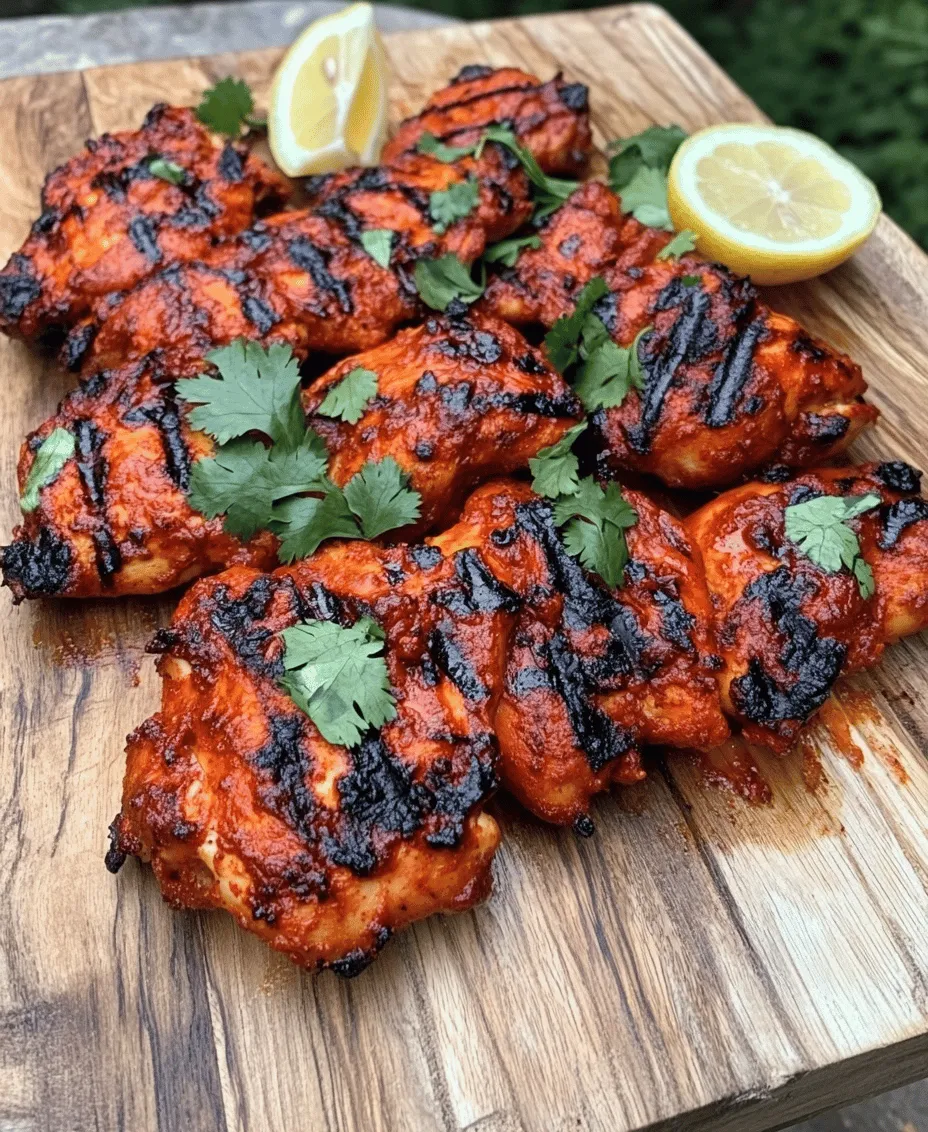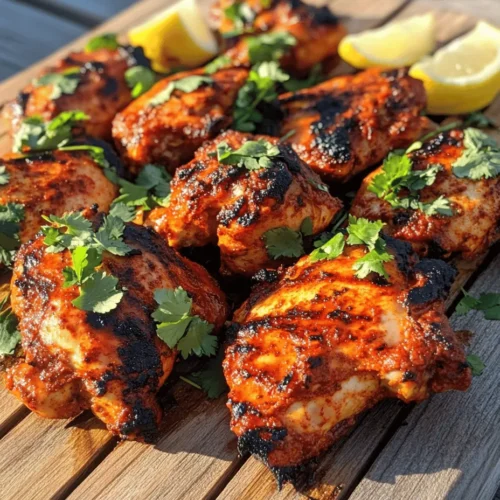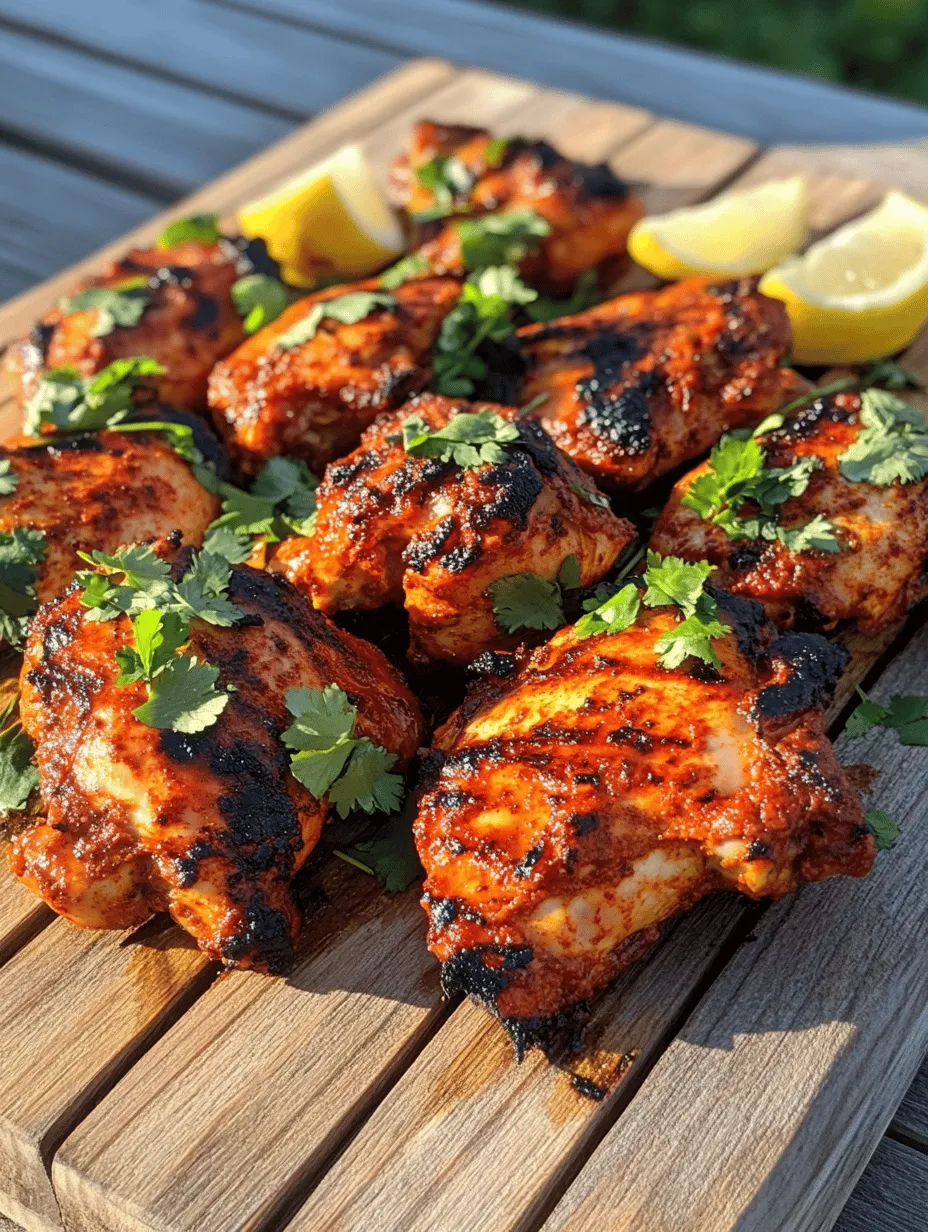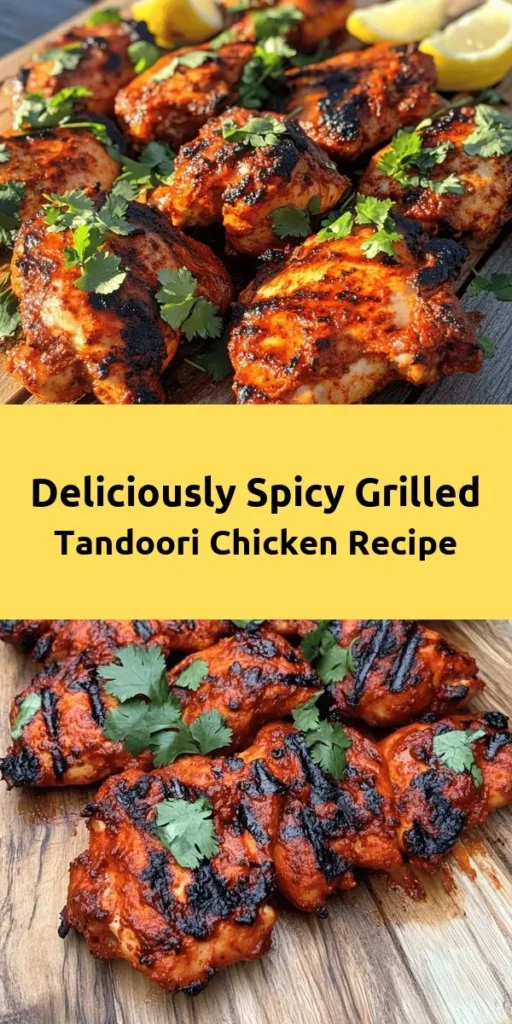Introduction
Tandoori chicken is an iconic dish that has captured the hearts and palates of food lovers around the world. Originating from the Indian subcontinent, this dish is celebrated not only for its vibrant color and tantalizing aroma but also for its rich and complex flavors that tell a story of tradition and culinary artistry. With its roots deeply embedded in Indian culture, tandoori chicken is often a centerpiece during festive occasions or family gatherings, making it a beloved staple in Indian cuisine.
The appeal of tandoori chicken extends beyond its taste. Grilled to perfection, it offers a healthier alternative to fried chicken, allowing you to enjoy a delicious meal without the excess calories. The unique combination of spices and the grilling process infuse the chicken with smoky flavors, making every bite a delightful experience. This recipe for Spicy & Smoky Grilled Tandoori Chicken is designed to bring the authentic taste of Indian cuisine into your home kitchen, making it easier than ever to impress your family and friends with your culinary skills.
Understanding Tandoori Chicken
At its core, tandoori chicken is marinated chicken that is traditionally cooked in a tandoor, a cylindrical clay oven that reaches high temperatures. The name “tandoori” comes from the word “tandoor,” which speaks to the cooking method that gives this dish its unique flavor profile. The use of a tandoor not only cooks the chicken evenly but also imparts a distinctive smoky taste that is hard to replicate with conventional cooking methods.
The magic of tandoori chicken lies in its marinade, which is a harmonious blend of spices, yogurt, and other ingredients. This marinade is essential for enhancing the flavor and tenderness of the chicken. The spices commonly used in tandoori chicken, such as cumin, coriander, turmeric, and garam masala, are not only integral to the dish’s flavor but also offer numerous health benefits, including anti-inflammatory properties and digestive support.
While the traditional method of cooking with a tandoor may not be accessible to everyone, grilling is a fantastic alternative that allows you to achieve similar results at home. By using a grill, you can replicate the high heat and smoky essence of tandoori chicken, ensuring that you still get that authentic taste without the need for specialized equipment.
Key Ingredients Breakdown
Bone-in Chicken Thighs
The choice of chicken is crucial in achieving the best flavor and texture in tandoori chicken. Bone-in chicken thighs are highly recommended for this recipe because they retain moisture during cooking, resulting in juicy and tender meat. The bones also contribute to the overall flavor, making the chicken more succulent compared to boneless cuts. If you’re looking to maximize flavor, chicken thighs are the way to go.
Plain Yogurt
Yogurt plays a vital role in the marination process. It acts as a tenderizer due to its acidity, helping to break down the proteins in the chicken. This not only enhances the texture but also allows the spices to penetrate the meat more effectively. Additionally, yogurt contributes a creamy consistency to the marinade, which helps to coat the chicken evenly.
Spices
The heart of tandoori chicken lies in its spices, each of which adds a unique depth of flavor. Here’s a closer look at some of the key spices used in this recipe:
– Coriander: Offers a citrusy and slightly sweet flavor, enhancing the overall taste of the marinade.
– Cumin: Adds a warm, earthy aroma that is essential in Indian cuisine.
– Garam Masala: A blend of spices that provides warmth and complexity, often associated with comfort food.
– Turmeric: Known for its bright yellow color and anti-inflammatory properties, it adds both flavor and health benefits.
– Cayenne Pepper: Infuses the dish with heat, allowing you to adjust the spice level according to your preference.
– Paprika: Contributes a mild sweetness and vibrant color to the marinade.
These spices not only create an explosion of flavors but also offer various health benefits, making this dish as nutritious as it is delicious.
Lemon Juice and Vegetable Oil
Lemon juice is another critical ingredient in the marinade. Its acidity helps to balance the richness of the yogurt and chicken, while also adding a fresh, tangy flavor that brightens the dish. Vegetable oil is added to the marinade to ensure that the chicken stays moist during grilling and to help the spices adhere better to the chicken’s surface.
Garlic and Ginger Pastes
Garlic and ginger are aromatic ingredients that elevate the flavor profile of tandoori chicken. Both ingredients provide depth and complexity, enhancing the overall taste of the dish. They also have their own health benefits, including antibacterial properties and digestive support.
Ingredient Substitutions
For those with dietary restrictions or preferences, there are several substitutions you can consider without compromising the integrity of the recipe. For instance, if you’re looking for a dairy-free option, you can replace plain yogurt with coconut yogurt, which will still provide a creamy texture and a hint of sweetness. If you’re sensitive to spice, you can reduce the amount of cayenne pepper or replace it with a milder spice.
Marination Process
Marinating chicken is a crucial step in this recipe, as it allows the flavors to infuse deep into the meat while also tenderizing it. A well-marinated chicken not only tastes better but also has a more appealing texture. Here’s how to properly marinate your chicken for the best results:
1. Mix the Marinade Ingredients Thoroughly: In a large bowl, combine all the marinade ingredients, ensuring that they are well-mixed. This will allow the flavors to blend and ensures that each piece of chicken will be evenly coated.
2. Coat the Chicken Evenly: Add the bone-in chicken thighs to the bowl and use your hands to rub the marinade all over the chicken. Make sure to get under the skin and into any crevices, as this will ensure that the flavors are well-distributed.
3. Recommended Marination Times: For optimal flavor penetration, allow the chicken to marinate for at least 4 hours, but ideally overnight. The longer the chicken marinates, the more flavorful and tender it will become. If you’re in a hurry, even a 30-minute marination can make a difference.
4. The Science Behind Marination: Marination works by breaking down the proteins in the meat, allowing flavors to penetrate and infuse. The acidity from the yogurt and lemon juice helps to tenderize the chicken while the spices create a flavorful crust when grilled.
By following these steps, you’ll ensure that your Spicy & Smoky Grilled Tandoori Chicken is bursting with flavor and perfectly tender, ready to be grilled to perfection.
Grilling Preparation
Once your chicken has marinated to perfection, it’s time to prepare for grilling. The grill will replicate the high heat of a traditional tandoor, creating a delicious char and smoky flavor that is signature to tandoori chicken. Here are some essential tips for grilling your chicken:
– Preheat the Grill: Ensure your grill is preheated to a high temperature. This is crucial for achieving that beautiful char and preventing the chicken from sticking to the grill grates.
– Oil the Grates: To prevent sticking, lightly oil the grill grates before placing the chicken on them. This will help maintain the integrity of the chicken and ensure it cooks evenly.
– Cooking Time and Temperature: Grill the marinated chicken thighs for about 20-25 minutes, turning every 5-7 minutes to ensure even cooking. Use a meat thermometer to check for doneness; the internal temperature should reach 165°F (75°C).
By following these guidelines, you’ll be well on your way to creating a delicious and authentic Spicy & Smoky Grilled Tandoori Chicken that’s sure to impress everyone at your dinner table.
Stay tuned for the continuation of this recipe, where we will explore serving suggestions, side dishes, and tips for enjoying your tandoori chicken to the fullest.

Preheating the Grill: Why Temperature Matters for the Perfect Char
Before diving into the grilling process, it’s essential to preheat your grill to ensure that your Spicy & Smoky Grilled Tandoori Chicken cooks evenly and develops that sought-after char. A properly preheated grill helps to sear the chicken, locking in moisture and flavor while creating a beautifully caramelized exterior.
For charcoal grills, allow the coals to burn until they are evenly coated with white ash, which typically takes about 15-20 minutes. For gas grills, set your burners to high and close the lid for about 10-15 minutes. Ideally, you want your grill to reach a temperature of around 400°F to 450°F. This high heat is crucial for achieving that smoky char that tandoori chicken is known for, as well as for reducing cooking time.
Preparing the Grill Grates to Prevent Sticking: Suggested Methods and Oils
Once your grill is preheated, the next step is to prepare the grill grates. This is vital to prevent your chicken from sticking and tearing during the cooking process. There are several effective methods to season your grill grates:
1. Oil the Grates: Using a paper towel or cloth, dip it into a high smoke-point oil, such as canola, grapeseed, or avocado oil. With a pair of tongs, wipe the oil over the grates to create a non-stick surface. This method also helps to infuse a bit of flavor into your chicken as it cooks.
2. Use a Grill Brush: If there are any remnants from previous grilling sessions, clean the grates with a grill brush before oiling them. This ensures that your chicken will have a clean cooking surface, which is essential for both flavor and hygiene.
3. Non-Stick Spray: If you prefer a quicker method, you can use a non-stick cooking spray. Just be sure to spray it on the grates when they are cool to avoid any flare-ups.
Safety Tips for Grilling Chicken, Including Checking for Doneness
Grilling chicken safely is crucial to ensure that it’s not only delicious but also safe to eat. Here are some essential safety tips:
– Use a Food Thermometer: The best way to ensure your chicken is cooked through is by checking its internal temperature. Chicken should reach an internal temperature of 165°F (74°C) to be considered safe for consumption. Insert the thermometer into the thickest part of the chicken without touching the bone.
– Avoid Cross-Contamination: Use separate utensils for raw and cooked chicken. Never place cooked chicken on a plate that previously held raw chicken to avoid cross-contamination.
– Keep an Eye on the Grill: Stay near your grill while cooking. This allows you to manage flare-ups and ensure that the chicken cooks evenly.
Grilling Techniques for Perfect Tandoori Chicken
With your grill prepped and safety measures in place, it’s time to get grilling. Here’s a step-by-step guide to achieving the perfect Spicy & Smoky Grilled Tandoori Chicken:
1. Placing Chicken on the Grill: Start by placing the marinated chicken pieces on the grill grates, ensuring they are spaced out to allow for even airflow. Avoid overcrowding the grill, as this can lead to steaming rather than grilling.
2. Timing and Flipping: Grill the chicken for about 6-8 minutes on one side without moving it. This allows the chicken to develop a nice sear. Once you see grill marks, flip the chicken using tongs. Grill the other side for another 6-8 minutes.
3. Check Internal Temperature and Visual Cues: After flipping, begin checking the internal temperature of the chicken pieces. For bone-in pieces, it may take longer, while boneless pieces will cook faster. Look for juices running clear and a golden-brown exterior as additional visual cues of doneness.
4. Balancing Smoky Flavor and Preventing Burning: To achieve that smoky flavor without burning your chicken, consider the following tips:
– If using a charcoal grill, add wood chips like hickory or mesquite to the coals to enhance smokiness.
– For gas grills, consider using a smoker box filled with wood chips to infuse flavor.
– Keep a close watch, especially during the last few minutes of cooking, as high heat can lead to burning.
Resting and Serving Suggestions
Once your chicken is grilled to perfection, it’s important to let it rest. Here’s why and how to serve it:
1. Importance of the Resting Period: Allow your grilled chicken to rest for about 5-10 minutes before cutting into it. This resting period helps redistribute the juices throughout the meat, resulting in a moist, flavorful bite.
2. Garnishing and Enhancing Flavors: For an appealing presentation and an extra burst of flavor, garnish your tandoori chicken with freshly chopped cilantro and serve with lemon wedges. Squeezing fresh lemon juice over the chicken just before eating enhances the spices’ brightness.
3. Suggested Side Dishes: Tandoori chicken pairs wonderfully with various side dishes. Consider serving it with:
– Naan: Soft, fluffy naan bread is perfect for scooping up chicken and sauces.
– Basmati Rice: Fragrant basmati rice complements the spices beautifully.
– Salads: A refreshing cucumber or mint salad can balance the heat of the spices.
4. Beverage Pairing Options: Elevate your meal with the right beverages. Traditional options include:
– Lassi: A yogurt-based drink that’s refreshing and helps cool the palate.
– Beer: A light lager or pilsner pairs nicely with the spices.
– Wine: Consider a chilled Riesling or Sauvignon Blanc to complement the flavors.
Culinary Variations and Customizations
One of the great aspects of tandoori chicken is its versatility. Here are some culinary variations and customizations to explore:
1. Different Proteins: While chicken is a classic choice, you can easily substitute it with:
– Lamb or Goat: For a richer flavor, marinate and grill lamb chops or goat pieces.
– Fish: Firm fish like salmon or swordfish can also be marinated and grilled, resulting in a quick and flavorful meal.
– Vegetarian Options: Consider using paneer, tofu, or vegetables like bell peppers and zucchini for a vegetarian tandoori dish.
2. Adjusting Spice Levels: Personalize your tandoori chicken by adjusting the spice levels in the marinade. If you prefer milder flavors, reduce the amount of cayenne or paprika. Alternatively, add more chili powder for an extra kick.
3. Regional Variations: Across India, tandoori chicken has regional variations that reflect local spices and cooking methods. For example:
– Punjabi Tandoori Chicken: This version typically uses yogurt and a blend of spices, including garam masala, making it rich and flavorful.
– Hyderabadi Tandoori Chicken: Known for its tangy flavor, this variation often incorporates vinegar and green chilies, giving it a unique taste.
Health Benefits of Grilled Tandoori Chicken
Not only is tandoori chicken delicious, but it also offers several health benefits:
1. Nutritional Benefits: Chicken is a fantastic source of high-quality protein, essential for muscle building and repair. The spices used in the marinade, such as turmeric and ginger, have anti-inflammatory properties, contributing to overall health.
2. Grilling vs. Frying: Grilling is a healthier cooking method compared to frying, as it allows excess fat to drip away from the meat. This reduces the overall calorie content and enhances the meal’s health profile.
3. Fresh Ingredients and Spices: Using fresh ingredients and spices in your marinade not only boosts flavor but also provides antioxidants and essential vitamins, promoting better health.
Conclusion
Making Spicy & Smoky Grilled Tandoori Chicken at home is a delightful culinary experience that brings the rich flavors of Indian cuisine right to your table. With its vibrant spices and smoky aroma, this dish is sure to impress your family and friends alike. By embracing this accessible recipe, you can explore the joy of cooking and sharing meals that celebrate cultural traditions.
As you gather around the table, take a moment to appreciate the flavors and stories behind each ingredient. Cooking is not just about nourishment; it’s about sharing love and creating lasting memories. So fire up the grill, savor the experience, and enjoy the delicious journey of tandoori chicken together with your loved ones.



